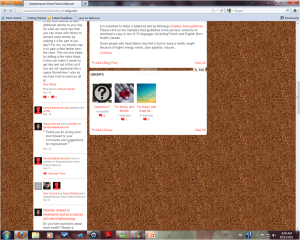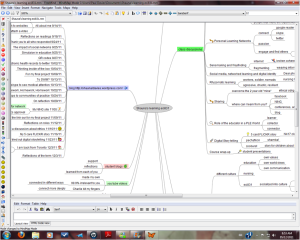For my major digital project in eci831, I chose to develop a site for patients with congestive heart failure, their friends and family so that they could come together, support each other and learn how to deal with this chronic condition. My interest in this are began as I have worked in cardiology for over 10 years and during this time I have seen frequent hospitalizations due to heart failure. The projected number of hospitalization due to heart failure is expected to rise. In Saskatchewan, many people diagnosed with heart failure receive teaching and support primarily from their physician. With the development of the site, I wanted to provide factual and current information to patients and family members as well as a place where they can come together to share stories, ask questions and relate any concerns. I chose to develop a NING site. NING is a social networking site. I chose this as it would provide an opportunity for me as a nurse to give information on topics such as congestive heart failure, diet, medications, and exercise. Overall I found the tool quite easy to use given my experience with blogging as I was able to post discussions, provide teaching, attach pictures and videos in a relatively easy manner. As I chose the basic format, I was limited in the background choices however overall it is acceptable. One of the key areas that I wanted to address was the theoretical framework for the study which related to the nursing theory of online social support which describes how the patient seeks health related information online and how family members and nursing can support the patient. My NING site was also influenced by connectivism as learning can occur in a network or community where there may be a variety of opinions. Here learning occurs outside of ourselves as we learn from each other and our connections.
I chose this as it would provide an opportunity for me as a nurse to give information on topics such as congestive heart failure, diet, medications, and exercise. Overall I found the tool quite easy to use given my experience with blogging as I was able to post discussions, provide teaching, attach pictures and videos in a relatively easy manner. As I chose the basic format, I was limited in the background choices however overall it is acceptable. One of the key areas that I wanted to address was the theoretical framework for the study which related to the nursing theory of online social support which describes how the patient seeks health related information online and how family members and nursing can support the patient. My NING site was also influenced by connectivism as learning can occur in a network or community where there may be a variety of opinions. Here learning occurs outside of ourselves as we learn from each other and our connections.
 As we learn from each it was important to include the discussion boards so that patients can talk to each other or to family or to a health care provider. Patients and families can choose when they want to access the information, how much they want to share as well as how they want to participate. Ideally this site would be open to the public so that anyone can join.
As we learn from each it was important to include the discussion boards so that patients can talk to each other or to family or to a health care provider. Patients and families can choose when they want to access the information, how much they want to share as well as how they want to participate. Ideally this site would be open to the public so that anyone can join.
At this time however, the only people who can access the site are those that I have granted permission. I chose to send the link out to registered nurses with experience in cardiology as patients could not access the site at this time. In order to have this site open to the public, I would require ethics approval. This is the next step that I am planning on doing. The reason that ethics is so important is due to HIPPA regulations as I cannot disclose patient names/medical conditions. I believe that I will be able to work around this if I can use other identifiers that will not give the person’s name out (like a combination of numbers and parent’s initials?). I was able to get some feedback from registered nurses. with experience in cardiology. I also had the opportunity to visit the heart failure clinic and discussed common issues/concerns that patients had so that I could address these on the site. I found these nurses to be very excited about the site due to need and requests of patients.
Overall, I did receive some valuable feedback for improvement of the site. Over the past two months I have made some changes. I will continue to further improve the site based upon current literature. I am also thinking of developing a section for children who may have a parent or grandparent with heart failure. I have made some initial strides with this as I developed a book using zooburst to introduce a young child to heart failure. I will continue to refine the book as I found the available images to be quite limiting when discussing heart failure. I am also planning on developing coloring book on heart failure as well.
There were many great videos available from YouTube on heart failure. I added a couple to the site and developed one of my own based on suggestions for improvement for the site. I used windows live movie maker to create the video. This was a quite the learning experience. For the video, I had to find pictures that would relate to heart health which was again challenging. I believe in the future I will buy or borrow a video camera so that I would have access to other images. The windows program itself was relatively easy to use. I found myself re-recording what I was saying as I did not like the tone of my voice. In the end, I am still not happy with my voice as it does not sound like I do in a regular conversation. This is definitely something that I am going to have to work on and revamp in following videos.
As I want the site to grow as learners take control and manage their own learning, I found that little discussion occurred on the site even from the nurses which is expected as they are familiar with the content. I was hoping for other suggestions on topics to add so that I can gain more experience adding to the site. Again this will have to wait until I have approval to open the site to the public.
Overall this platform will meet or exceed expectations for the site. I believe that the site will be valuable for patients and families. Ultimately I hope that other sites dealing with medical conditions will be made available online to support those patients living in remote and rural areas who do not have the opportunity to go to a face-to-face meeting.
My biggest learning to date is that I can manage to provide this information to patients and families as I have developed the skills to start a discussion, post videos, attach links to websites all of which are skills that I did not have prior to starting the course. Previously I was considering hiring someone with a computer science background but now I can manage this myself.
Please keep checking back as I hope that in a future post you will have the link to the Saskatchewan Heart Failure Network.

















